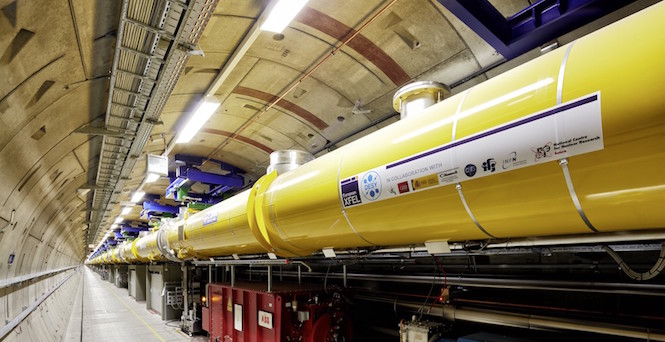URL: https://v1.desy.de/site_www-desy/content/research/facilities__projects/european_xfel/aufgabenuebersichtsplan_v1_20220131_eng.html/@@siteview
Breadcrumb Navigation

European XFEL
X-ray laser European XFEL
The Hamburg area boasts a research facility of superlatives: The European XFEL generates ultrashort X-ray flashes – 27 000 times per second and with a brilliance that is a billion times higher than that of the best conventional X-ray radiation sources. The facility opens up completely new research opportunities for scientists and industrial users. As the main shareholder, DESY is playing a major role in the operation of the X-ray laser.
Movies of chemical reactions that take place in fractions of a second; images of proteins in which every atom can be seen; pictures of nanomaterials that show the tiniest details; or insights into the states of matter inside giant planets or stars – the European XFEL X-ray laser makes such experiments possible.
A major international project
The European XFEL, which is installed in underground tunnels, is more than three kilometres long and stretch from the DESY site in Hamburg to the town of Schenefeld in the German federal state of Schleswig-Holstein, where the resarch campus with a large experimental hall is located. The billion-euro project is an international joint undertaking for which a separate company, the European XFEL GmbH, was established. Besides Germany, eleven other countries are involved.
DESY, the main shareholder, is working closely with European XFEL on the operation of the facility. Among other things, DESY and its international partners have built the heart of the X-ray laser – the 1.7-kilometre-long superconducting accelerator including the electron source, which DESY now also operates. The accelerator is based on the superconducting TESLA technology, which DESY and its partners developed within the TESLA Technology Collaboration. Since 2005, DESY has been operating the free-electron laser FLASH, a 300-metre-long prototype of the European XFEL based on the same technology.
Light source of the future
The accelerator of the European XFEL brings electrons to almost the speed of light and then sends them through long undulators. These special magnets force the electrons onto slalom paths, causing the particles to emit extremely short and powerful X-ray flashes. Unlike the X-ray pulses produced in a storage ring, these flashes have laser properties – which is what makes certain experiments possible in the first place, such as recording holograms.
There are X-ray lasers of a similar size in Japan and the USA. The European XFEL was the first of these facilities with a superconducting accelerator. Until then, X-ray lasers could only produce relatively few flashes per second. The European XFEL, on the other hand, generates 27 000 flashes per second, which offers a decisive advantage in various experiments.
Unique insights into the microcosm
Scientists from a range of disciplines benefit from the new super laser: Biologists obtain detailed images of cell components, individual protein molecules and viruses. The results help to combat diseases and develop new medications. Chemists can film reactions and observe in slow-motion how individual atoms react with one another. The knowledge thus gained can help to optimise industrially relevant catalysts, for example.
Physicists and materials scientists study the exact structure of nanomaterials. Such materials play an important role when it comes to developing more effective solar cells, fuel cells and data storage systems. Astrophysicists analyse extremely hot and compressed material samples. These provide insight into the interior of stars and planets and help reveal the extent to which nuclear fusion processes are suitable as a new source of energy.
- European research institution with strong DESY participation
- Construction and operation: European XFEL GmbH (non-profit)
- Free-electron laser with superconducting linear accelerator in TESLA technology
- Total length: approx. 3.4 kilometres
- Generates extremely brilliant X-ray laser radiation using the SASE principle (wavelengths tunable between 0.05 and 4.7 nanometres)
- In operation since 2017
- One underground experimental hall with currently seven measuring stations


